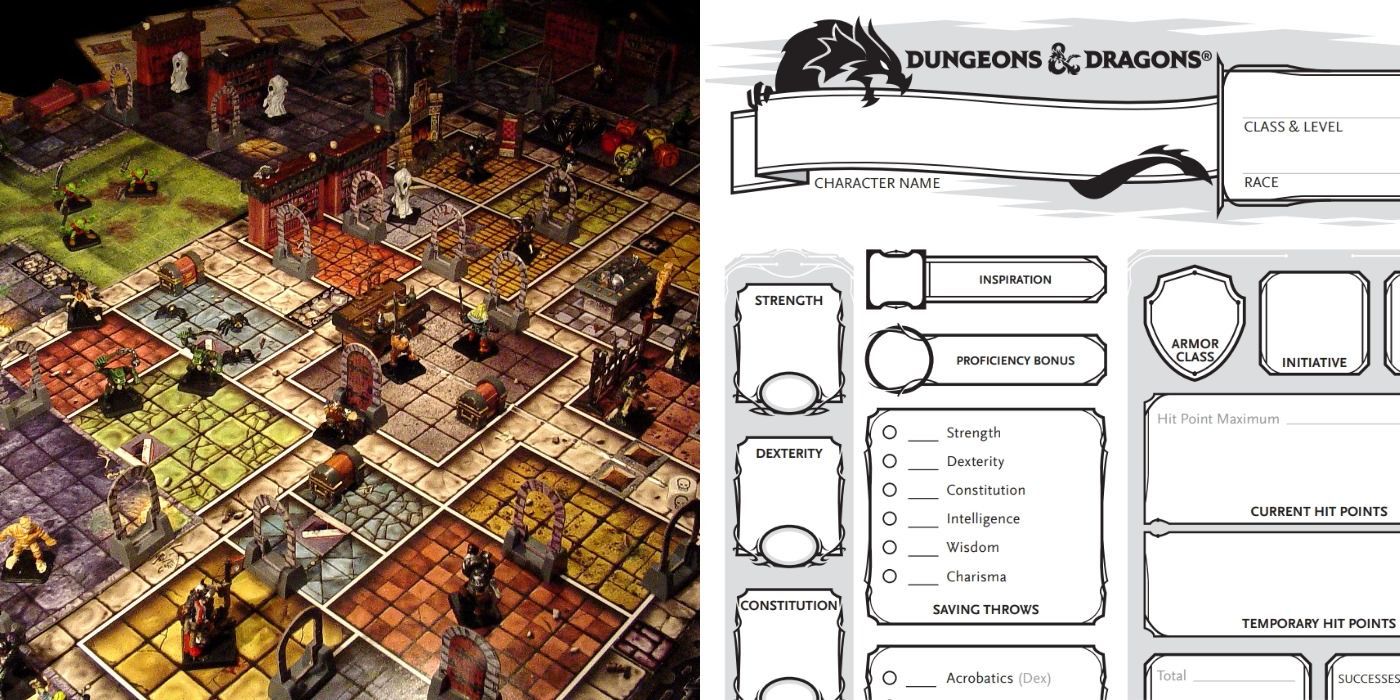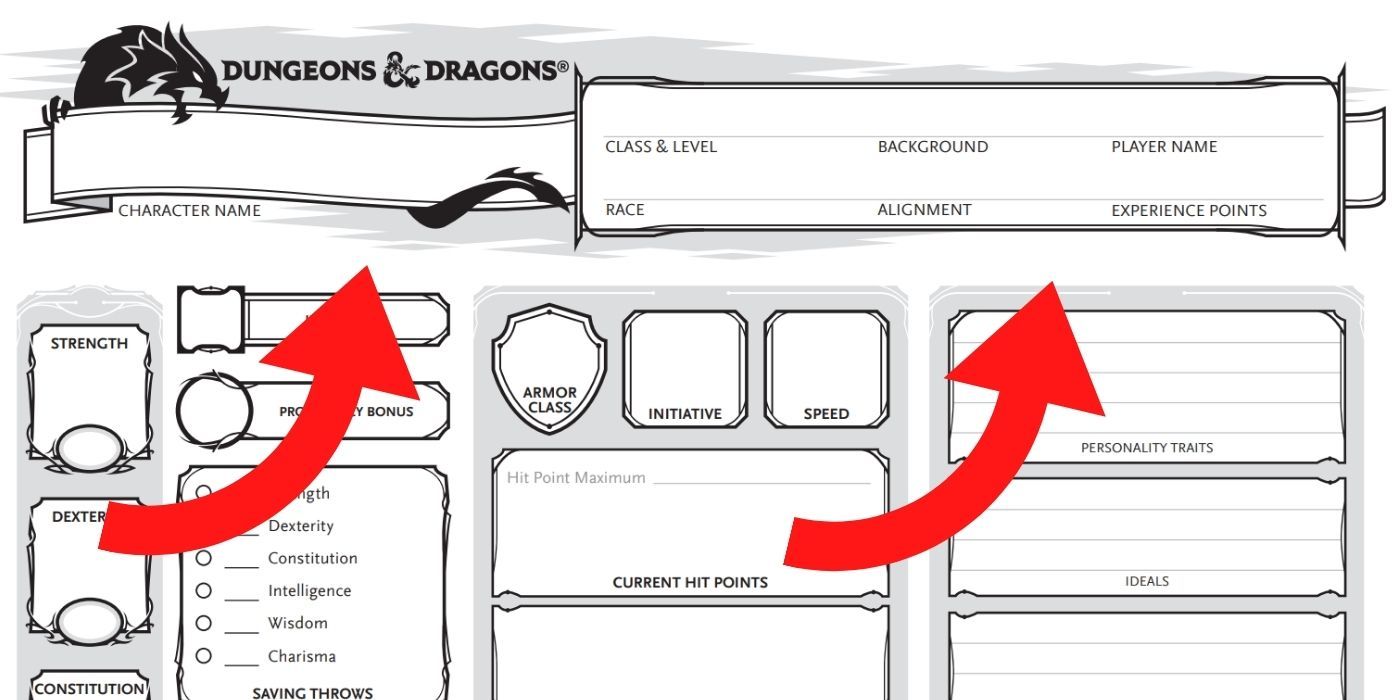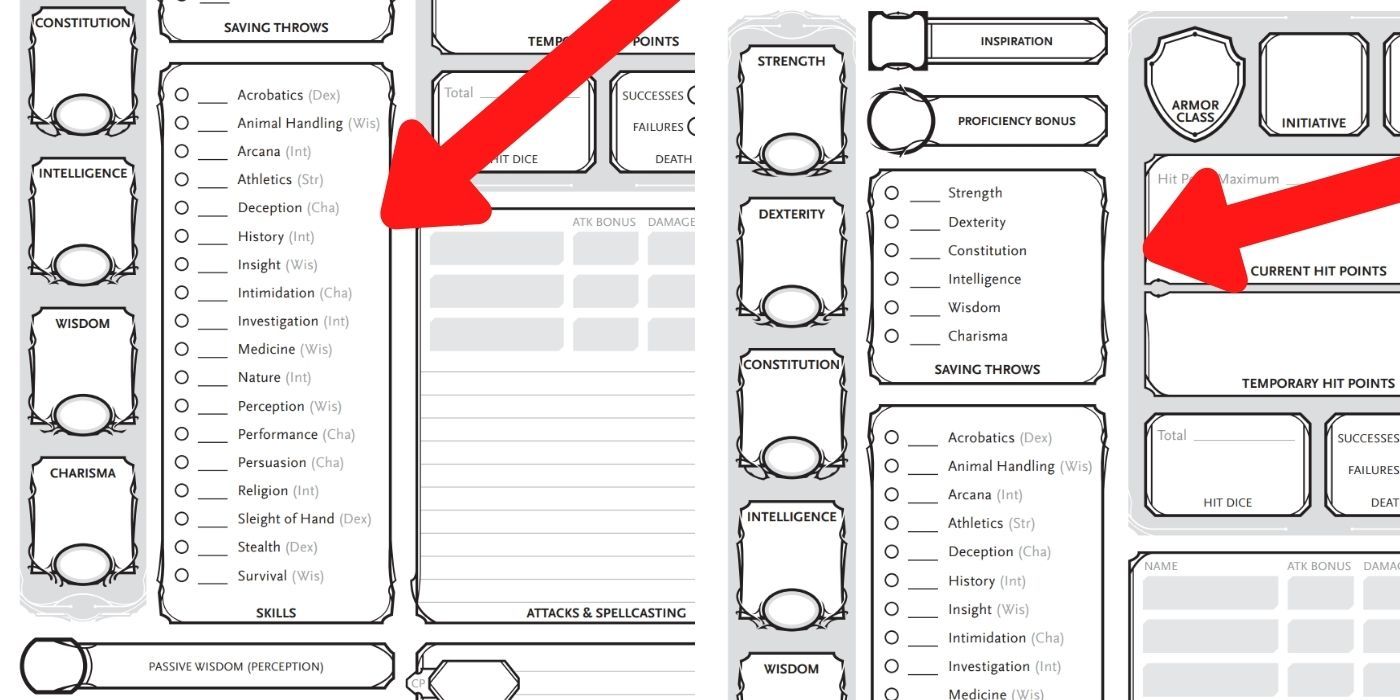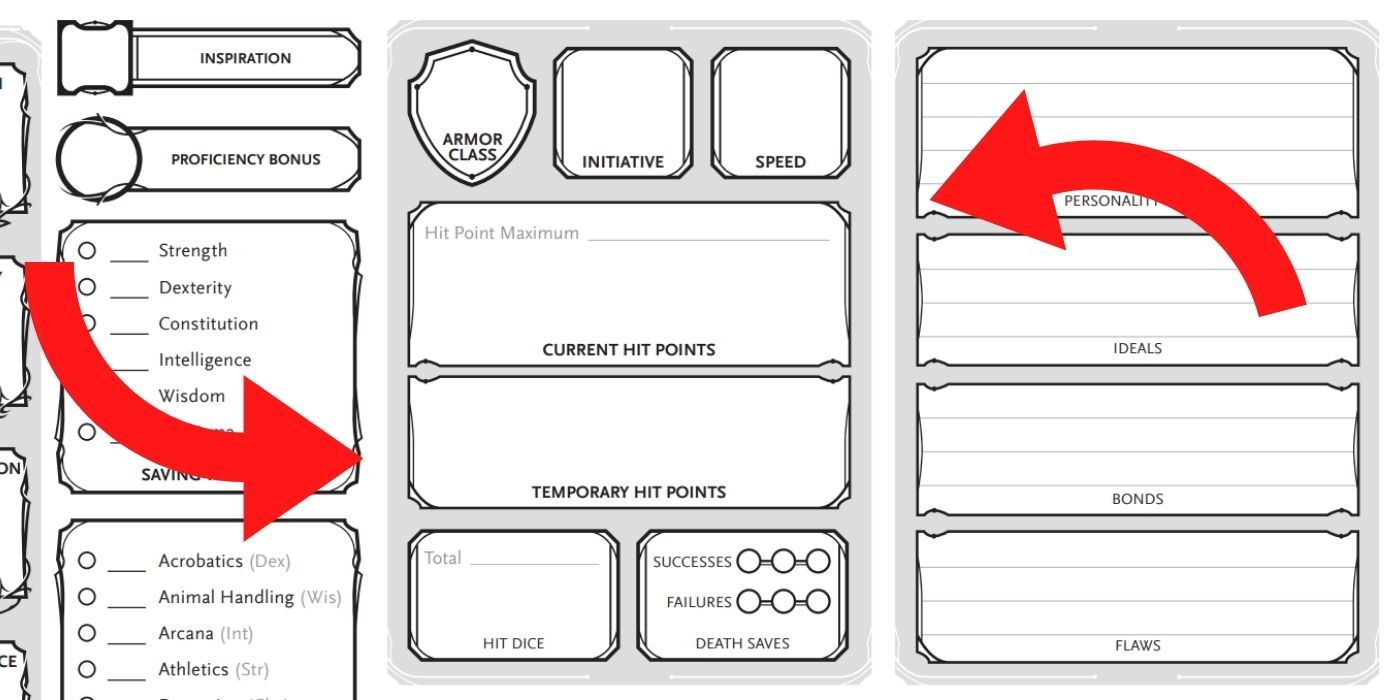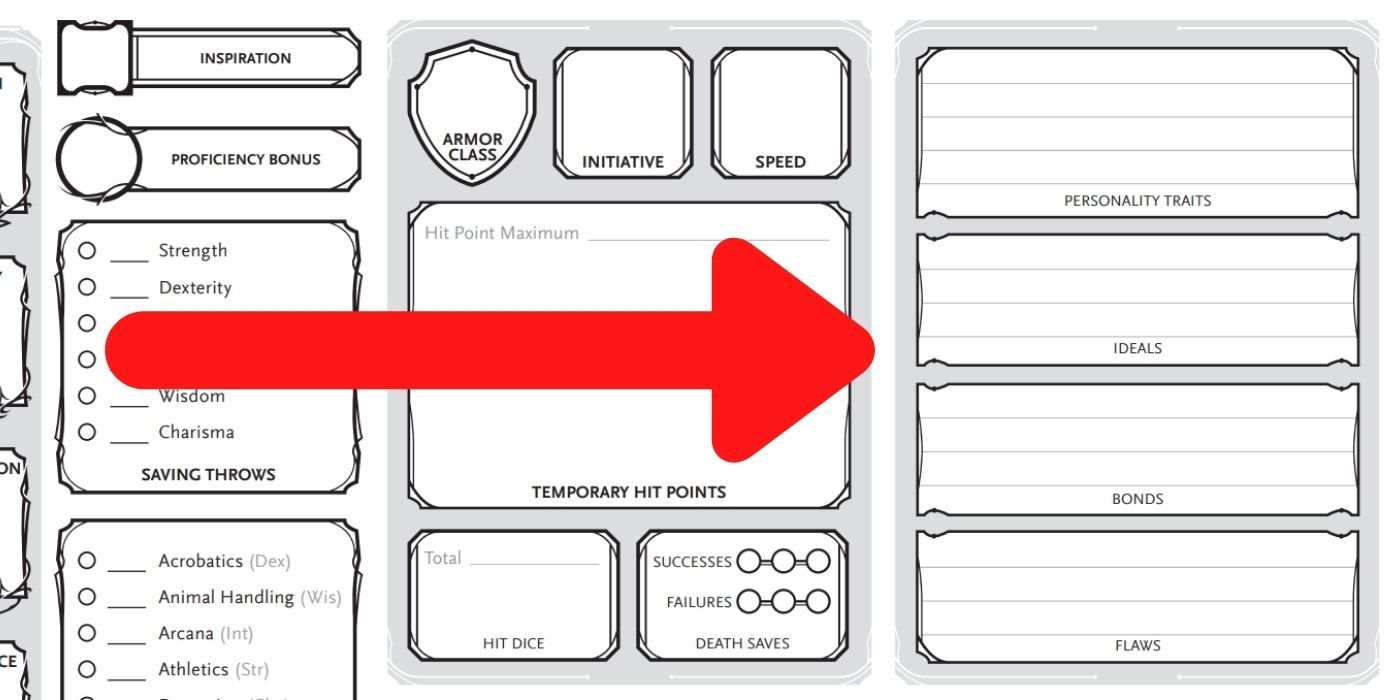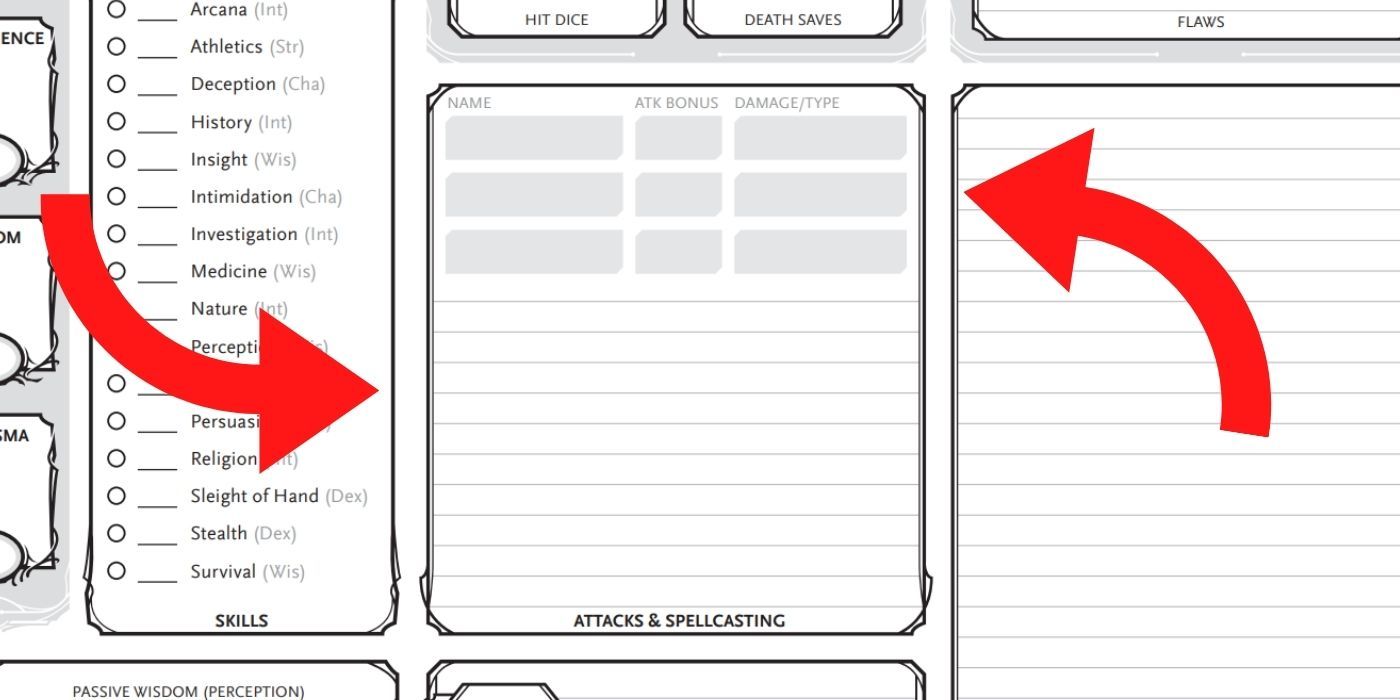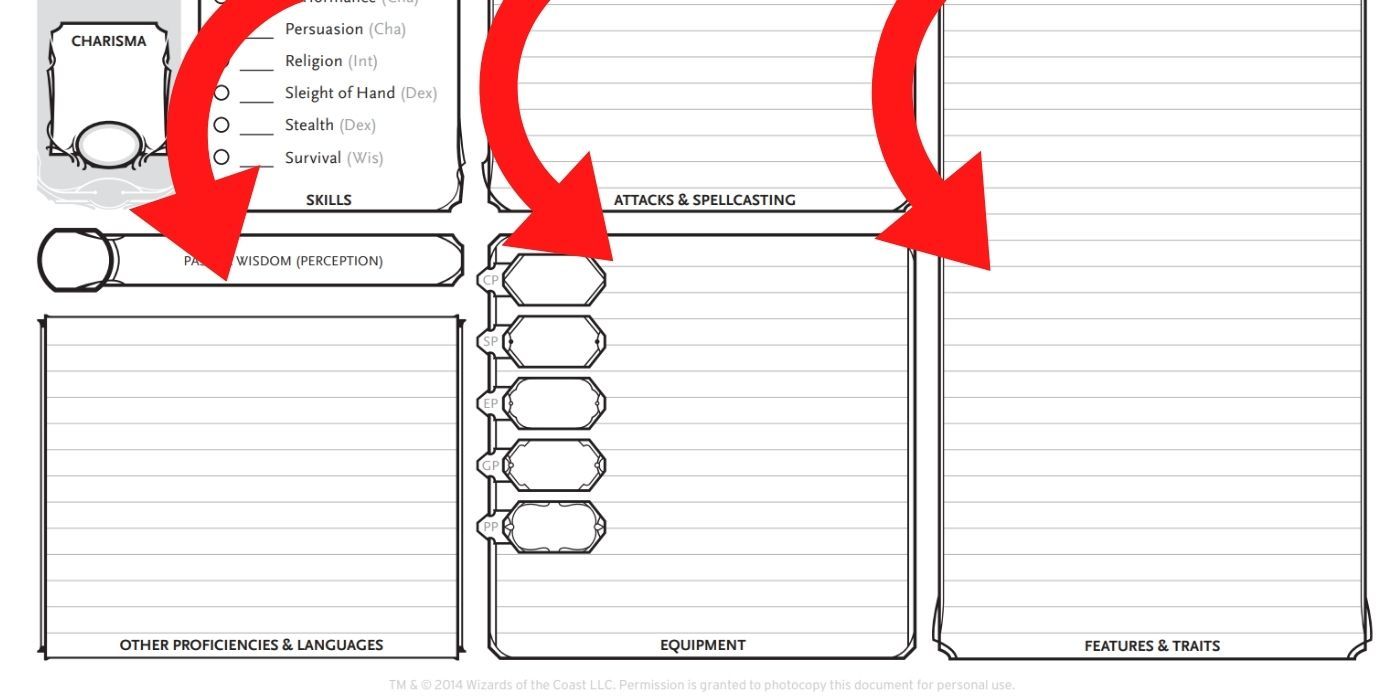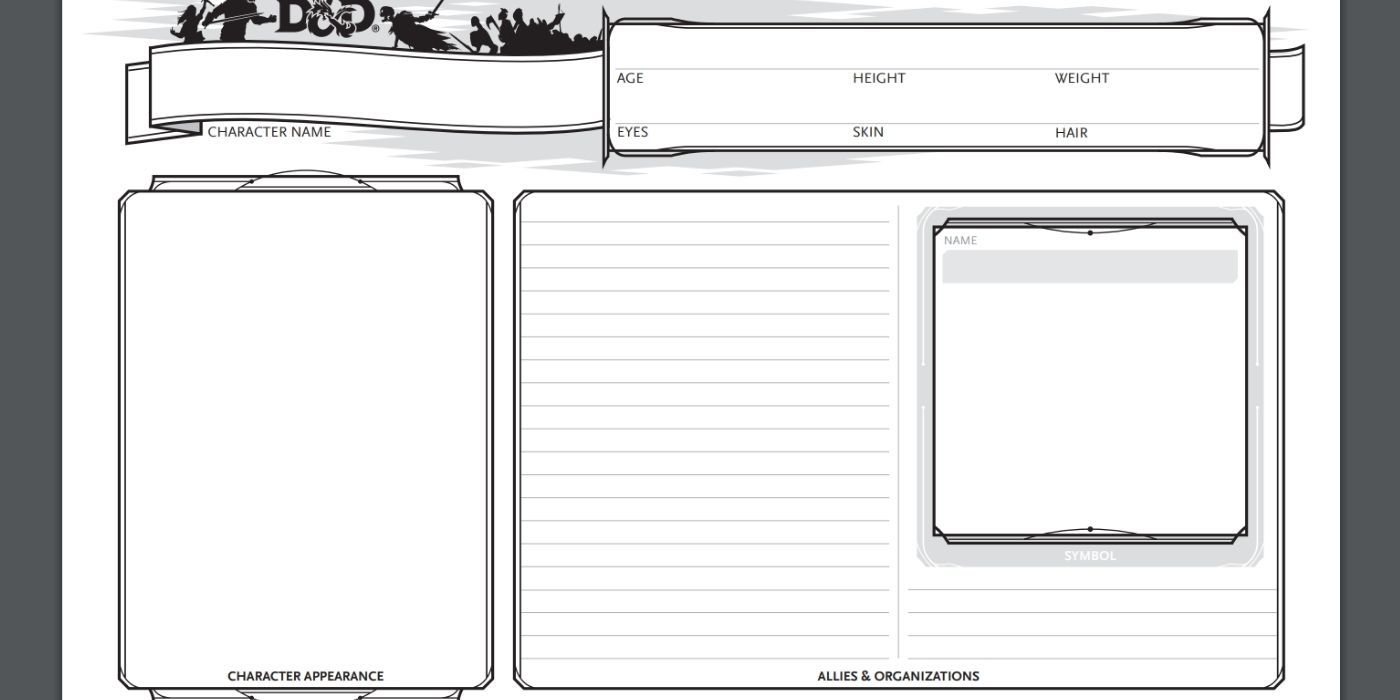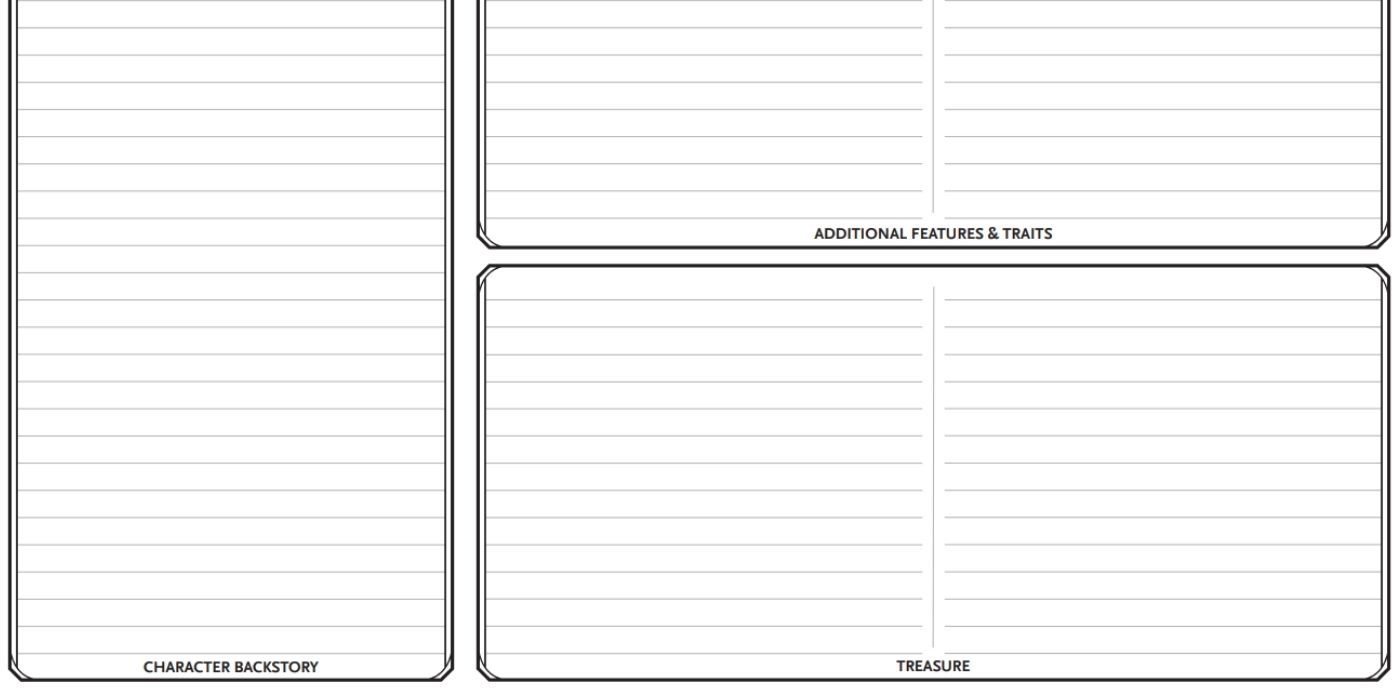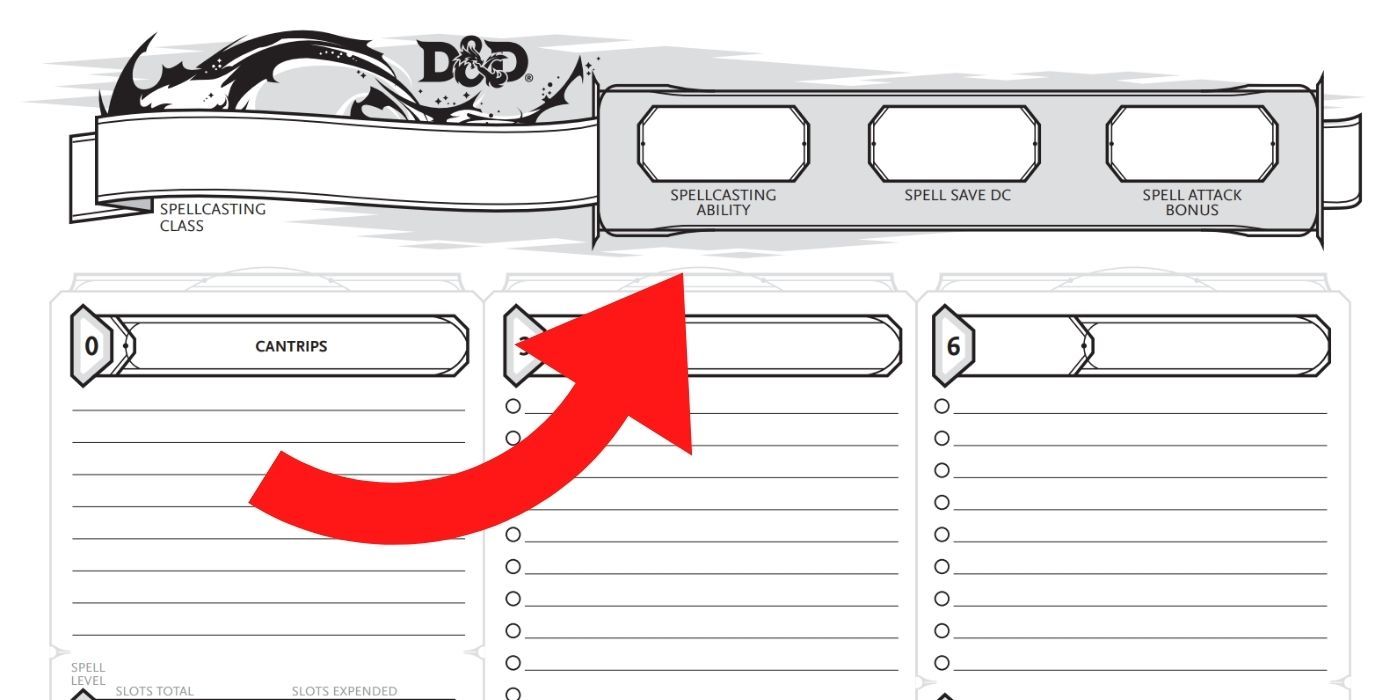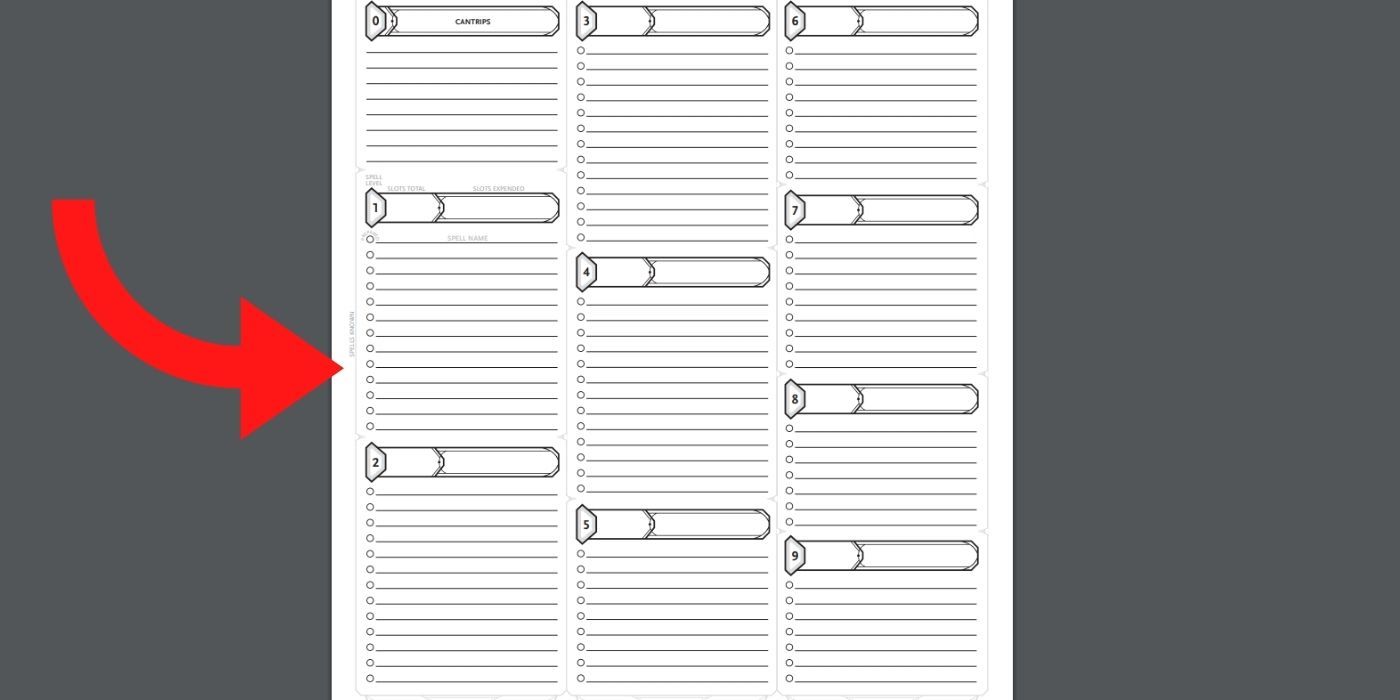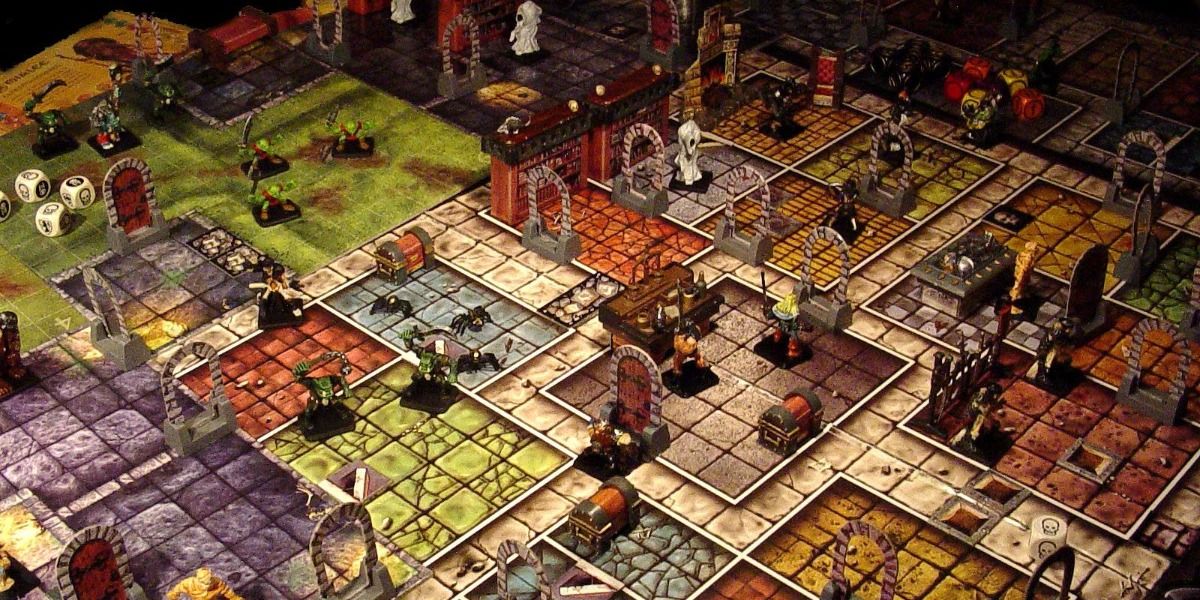The character sheet is the core of any good Dungeons and Dragons campaign. For the dungeon master, it provides essential insight into the player's decisions and characters. For the players, creating their character is often the first time they really think about who or what they want to be for the campaign, and often begin to engage with the other players about connected backstories, potential romances, and more.
Three pages of blank space, however, can be rather daunting. It has to be completed before the game can start, but it means that new players don't get a sense of how everything works before they have to make crucial decisions. This guide will give you a sense of what will be useful to you and what you can set aside to look into later, as well as suggest times when the traditional character sheet just can't cut it.
The Main Page
The Basics
These details are the essential things to know about your character. If another player needs a reminder of your in-game name or race, or your dungeon master (DM) wants to check your alignment to challenge your roleplaying, it doesn't hurt that they're right at the top for a quick peek.
The character's name can be anything, but the Player's Handbook provides examples to choose from or use as a basis. If the party is lacking a copy of the Handbook, online name-generators are the next best thing!
The class and level section can and will change as the character progresses through a story (or stories). The maximum is level 20, which the player can divide into multiple different classes (in order to combine abilities in unique ways) as they choose. Players can reach new levels through gaining experience from each encounter (combat or not), recorded in that sub-heading, or as milestones, which means the dungeon master will instruct the players to level up once they reach certain story beats.
The background and alignment details are less likely to change. It would only happen through dramatic changes or life events that a character experiences — something so life-changing that their fundamental being is altered. The background describes how the character lived before the campaign began, and the ones outlined by the Player Handbook come with particular stat changes. The alignment describes how the character deals with moral questions and makes decisions in their life. The dungeon master can hold a player to their chosen alignment if they think the player is doing something unrealistic for their character.
Abilities
Ability scores denote a character's physical and mental capabilities. The six main scores (strength, dexterity, constitution, intelligence, and wisdom) are the most important.
Players may generate their ability scores through several methods. A DM may or may not tell players which method they have to use.
The Handbook describes the random method, in which the player rolls dice to get six scores, and then assigns those six scores to each of the six abilities. Most dungeon masters who follow this method will be a little forgiving for players who get truly terrible roles, but exactly how forgiving they are is up to them. This method is favored by DMs that want to stop the players from min-maxing or power gaming (creating perfect characters with no flaws, or simply making them overpowered).
The "point buy" method means that the six stats start with 8 points each, and the player has 27 points to assigns to abilities as they prefer. It means that no character will start with a stat lower than -1. It's usually used by two kinds of players: the ones who have a particular character in mind already and want to ensure their stats line up with their personality and backstory, or by players who are extremely familiar with the rules and want to perfect their abilities for their class and background.
The final common method, used least often, is the "standard array" method. The player is given an 8, 10, 12, 13, 14, and 15 to assign wherever they prefer. DMs favor it for new players, so they aren't overwhelmed by the character creation process.
Each major ability corresponds to more specific skills. The skill bonus is the same as the ability bonus, unless the character has a reason it should be more or less. For example, proficiency in a particular skill would mean that the player gets a bonus when using the skill. Players can denote whether or not they are proficient in a skill by filling in the circles.
Combat Stats
This section includes the stat details for combat encounters. Hitpoints equal how much health a character has (or how many hits they can take from enemies before fainting). The total number of hit points that a character is determined by their class and their constitution stat. The hit die is the kind of die that a particular class uses to roll their hit points. Temporary hit points are essentially "bonus health" provided by spells, potions, or other means.
Death saves are relevant if a character runs out of hit points and faints. On their turn, the player rolls dice to make a "death save." If they roll high enough they succeed, and if they don't they fail. Three successes bring the character out of unconsciousness, but three failures kill the character permanently.
The speed decides how far a character can move during combat and is determined by a number of factors. The initiative affects when a character will take their turn in combat; it's nice to know when to zone out since combat can be especially long. The armor class denotes how much armor the character is wearing and how good an attack needs to be to pierce it and injure the character.
Roleplaying Essentials
The details on the side are meant to give you a brief overview of a character's personality without delving into pages of backstory. Each section's answers can be made up by the player or pulled from examples in the Handbook. This section doesn't need a lot of details; try to break big ideas down into single points or sentences.
Bonds are people or organizations that the character cares about or finds themselves deeply connected to. Flaws are exactly what they sound like: personality quirks that aren't ideal, which the character might even be ashamed of. Ideals can be goals the character wants to accomplish or rules they would never break. And the personality traits section is open space for a few extra details — as the player determines them important!
Attacks
The attacking box is used to detail the weapons and damage-dealing spells that a character can use on their enemies.
For weapons, it should include which dice and how many to roll for damage, any applicable bonuses to the damage, and what kind of damage the weapon deals (piercing, bludgeoning, etc.). All these details can be found in the official rules.
For spells, it's much the same. It should tell the player how much damage a spell will do, in what radius or area, how to cast it and with which dice, and what kind of damage it deals (fire, ice, mental, etc.).
Extra Details
The Features and Traits section is long so that the players can write down the important details; features or traits are passive qualities the character has that impact the game. One common example is 'Darkvision.' It's a trait that many races have that allows them to see in the dark; if a character doesn't have it, they're at a severe disadvantage underground, in caves, in dimly lit castles, etc. There are so many of these that a player could never be expected to memorize them all.
The Equipment section is like the character's inventory. It lists anything the character has on their person at that time, including their money. It's important to keep this section up to date, since DMs may question if you actually have an item, like rope, when you go to use it. If it's not on your equipment list, you're doomed.
The last section, Other Proficiencies and Languages, details extra skills the character might have that don't fit into the skills. Proficiencies in a particular kind of weapon or a certain instrument, for example, might go here. Any language that the character speaks other than 'Common' should be listed here too since many races or regions have a unique language.
The Character Details Page
Character Appearance And Organizations
The second page, character details, allows players to expand their backstory beyond the basics. Their physical description, including their age, height, etc., can be listed here to refer back to. If the player is an artist, there's blank space to doodle them. Any groups or organizations that the character is a member of can be listed, as well as specific contacts they have.
Character Backstory, Treasure, And Extra Features
As the player increases in levels, they can accrue a lot of features, so there's extra space on the second page to detail them. The treasure section lists the loot and riches that characters may have gained during their adventures that they don't carry on them at all times, but are still important to record. The character backstory section is, just as it sounds, the most relevant details that led the character to the present campaign. If the player prefers, they could leave it blank and just record the events of different campaigns that this character takes part in.
The Spell Page
Spell-Casting Details
If the player has chosen a class that can cast spells, they'll also need the third page. Each class uses a different ability to determine how effective their spell-casting is:
- Charisma: Bard, Warlock, Paladin, and Sorcerer
- Wisdom: Cleric, Druid, and Ranger
- Intelligence: Fighter (Eldritch Knights), Rogue (Arcane Tricksters), and Wizard
The spell save DC denotes how difficult it is for a target to resist your spell, and the attack bonus is added to the dice roll for the spell's damage.
Spells
The rest of the page is for the player to list which spells they know. As they become stronger (and increase in levels), characters will learn more powerful spells. The lefthand number denotes the spell's level, the next space indicates how many spell slots a player has (how many times the character can cast a spell from that level before they take a rest), and the last space indicates how many spell slots the player has already used up.
When Not To Use A Character Sheet
Players should consider an alternative character sheet anytime they feel like the page isn't serving them effectively enough, but these are a few common situations.
For Characters That You've Played Before
Some players are so consistent that they use the same character for multiple campaigns, building up their story and personality over time. Characters developed this way are undoubtedly among the best, most fleshed-out in D&D. However, they inevitably accrue so much information and details that they can't be contained in a character sheet's three measly pages.
- Alternative: anything that allows unlimited (or practically unlimited) details and additions to a character — online character sheet websites, phone apps that help players create and maintain characters, or fillable spreadsheets for the character's details
For Homebrew Games
Homebrew games of Dungeons and Dragons are campaigns that include things that aren't in the traditional rules of Dungeons and Dragons. It may mean unique equipment or spells, it may mean that the DM includes special rules for combat or spell-casting, it may mean extra races or classes, or it could mean a complete overhaul of the normal rules to Dungeons and Dragons. How different the homebrew is will determine how customizable the character sheet needs to be.
- Alternative: anything that is customizable enough to serve the rules of the homebrew — alternate character sheet setups (fillable pdfs or printed paper), online character sheet websites, phone apps that help players create and maintain characters, or fillable spreadsheets for the character's details
If You Have Bad Or Large Handwriting
Some players just can't stand their own handwriting, or naturally write in large letters that would quickly fill up the usual character sheet. If this is the case, an online format with standardized fonts or a character sheet with more room to write could be the best solution.
- Alternative: alternative character sheet setups, online character sheet websites, phone apps that help players create and maintain characters, fillable spreadsheets for the character's details, or fillable PDFs of the basic character sheets from the Wizards of the Coast website
When You're Worried About Losing It
D&D players lose their character sheets all the time. It may be because the player is naturally forgetful or disorderly, the player forgot to bring it to a session, there's a long span of time between sessions of the campaign, or any number of other reasons. Using an online character sheet alleviates the pressure of keeping track of the sheet.
- Alternative: anything online that the player will always have access to — online character sheet websites, phone apps that help players create and maintain characters, fillable spreadsheets or PDFs for the character's details that can be stored on the cloud
If The Game Is Hosted Online
Online games of D&D are more and more common in recent months, with reliable sites popping up to form parties with other players around the world. Lots of people prefer paper character sheets for the tactile experience of playing in person, without computer screens between the players. If your party is playing over the internet, using a character sheet may be harder than it's worth.
- Alternative: online character sheet websites, phone apps that help players create and maintain characters, fillable spreadsheets for the character's details, or fillable PDFs of the basic character sheets from the Wizards of the Coast website
For Accessibility Reasons
There are a number of reasons why filling out a character sheet and keeping it updated isn't accessible to everyone. It might be a problem with the player's mobility, or just that they find the sheet layout hard to keep up with.
- Alternative: player specific — choose an app, unique alternate character sheet, or other solution with the help of your DM
If You Need To Keep Your DM Updated
Some DMs ask for or even require constant access to the player's character sheets. This may be because of the particular campaign being run, just because the DM likes to stay informed, or for other reasons. In this case, paper character sheets aren't always effective (especially if the DM wants access to the character sheets in the middle of a session, and not just between games).
- Alternative: electronic, public character sheets such as the ones that can be made through D&D Beyond (just be sure that the players aren't looking at one another's character sheets without permission)

